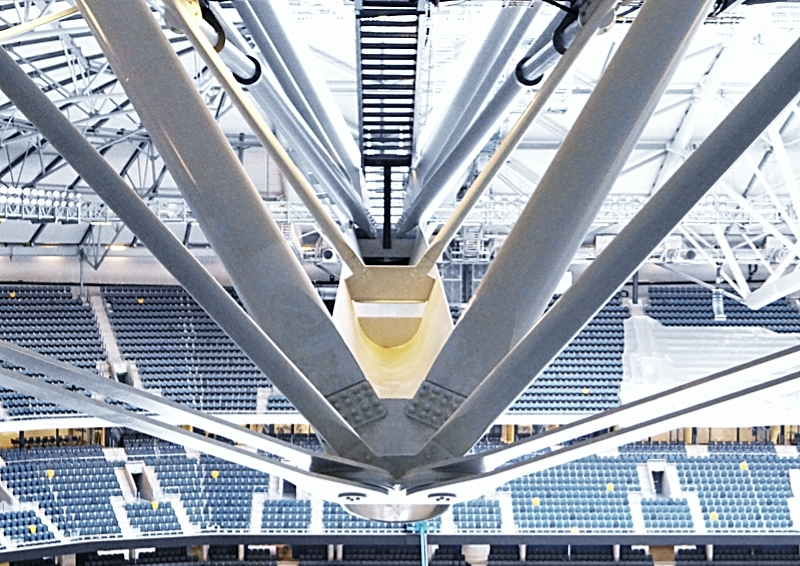Types of structure

|
[edit] What is a structure?
Within the context of the built environment, the term ‘structure’ refers to anything that is constructed or built from interrelated parts with a fixed location on the ground. This includes buildings, but can refer to any body that is designed to bear loads, even if it is not intended to be occupied by people (engineers sometimes refer to these as 'non-building' structures – such as bridges, tunnels, and so on).
[edit] What are the main classification types for structures?
Structures can be classified in a number of ways:
- Type.
- Structural system.
- Application.
- Form.
- Material.
- Element.
- Overall shape.
[edit] How are structures defined by type?
Types of structural systems include:
[edit] How are structures defined by system?
Types of structural system include:
[edit] How are structures defined by application?
Applications of structures include:
- Building.
- Aqueducts and viaducts.
- Bridges.
- Canals.
- Cooling towers and chimneys.
- Dams.
- Railways.
- Roads.
- Retaining walls.
- Tunnels.
- Coastal defences.
[edit] How are structures defined by form?
- One-dimensional: Ropes, cables, struts, columns, beams, arches.
- Two-dimensional: Membranes, plates, slabs, shells, vaults, domes, synclastic, anticlastic.
- Three-dimensional: Solid masses.
- Composite. A combination of the above.
[edit] How are structures defined by material?
Structural materials include:
- Timber and similar materials such as bamboo, plywood, and engineered timber.
- Concrete.
- Metal: Steel, aluminium and so on.
- Masonry: Brick, block, stone and so on.
- Glass.
- Adobe, earth, clay, cob and so on.
- Fabric, such as fabric membranes.
- Composite, such as structural insulated panels.
[edit] How are structures defined by element?
Structural elements include:
- Substructure.
- Superstructure.
- Foundation.
- Roof.
- Shell and core.
- Structural frame.
- Floor.
- Wall: loadbearing walls, compartment walls, external walls, retaining walls.
See Elements of structure in buildings for more information.
[edit] How are structures defined by overall shape.
Overall shapes of structures include:
- Low-rise.
- Multi-storey.
- Mid-rise.
- High rise.
- Groundscraper.
- Skyscraper.
- Supertall.
- Megatall.
- Super-slender
- Megastructure.
- Anticlastic.
- Synclastic.
- Hyperbolic paraboloid.
- Conoid.
- Tower.
- Dome.
[edit] Related articles on Designing Buildings
- Civil engineer.
- Deflection.
- Elements of structure in buildings
- Engineer.
- Platform construction.
- Span.
- Structure.
- Structural engineer.
- Structural principles.
- Substructure.
- Superstructure.
- The development of structural membranes.
- Types of beam.
- Types of building.
- Types of column.
- Types of construction.
- Types of wall.
- Types of structural load.
Featured articles and news
Amendment to the GB Energy Bill welcomed by ECA
Move prevents nationally-owned energy company from investing in solar panels produced by modern slavery.
Gregor Harvie argues that AI is state-sanctioned theft of IP.
Heat pumps, vehicle chargers and heating appliances must be sold with smart functionality.
Experimental AI housing target help for councils
Experimental AI could help councils meet housing targets by digitising records.
New-style degrees set for reformed ARB accreditation
Following the ARB Tomorrow's Architects competency outcomes for Architects.
BSRIA Occupant Wellbeing survey BOW
Occupant satisfaction and wellbeing tool inc. physical environment, indoor facilities, functionality and accessibility.
Preserving, waterproofing and decorating buildings.
Many resources for visitors aswell as new features for members.
Using technology to empower communities
The Community data platform; capturing the DNA of a place and fostering participation, for better design.
Heat pump and wind turbine sound calculations for PDRs
MCS publish updated sound calculation standards for permitted development installations.
Homes England creates largest housing-led site in the North
Successful, 34 hectare land acquisition with the residential allocation now completed.
Scottish apprenticeship training proposals
General support although better accountability and transparency is sought.
The history of building regulations
A story of belated action in response to crisis.
Moisture, fire safety and emerging trends in living walls
How wet is your wall?
Current policy explained and newly published consultation by the UK and Welsh Governments.
British architecture 1919–39. Book review.
Conservation of listed prefabs in Moseley.
Energy industry calls for urgent reform.

























Comments
[edit] To make a comment about this article, click 'Add a comment' above. Separate your comments from any existing comments by inserting a horizontal line.